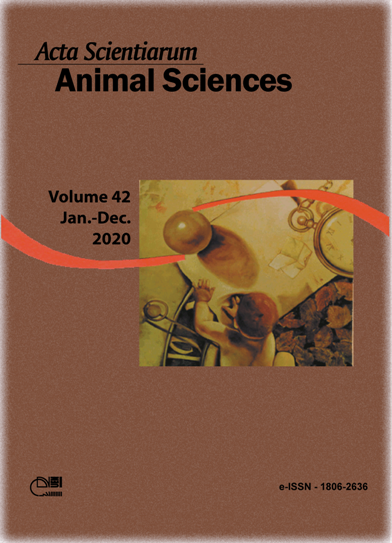Physicochemical characterization of by-products from beef cattle slaughter and economic feasibility of commercialization
Resumo
The aim was to evaluate the proximate food composition, cholesterol content, coloring and economic aspects of the main nutrients present in by-products from the slaughter of cattle. The samples were collected from 14 organs, with four repetitions each, of which we conducted the analyses of moisture, crude protein, mineral matter, cholesterol and fat content. The color was measured through the coordinates L*, a*, b*. The differences between the groups of red and white viscera were evaluated by contrasts analysis. Subsequently, the data were subjected to multivariate analysis of variance, which was complemented by the principal component technique. In the analysis of contrast between red and white viscera, the results showed that the components with the highest content of total fat does not necessarily have the highest content of cholesterol and vice-versa. For minerals, the red viscera presented higher content than white viscera and, in order to analyze the protein composition, there was less variability for red viscera in relation to white viscera. In the color analysis, the values for the color readings indicated uniformity between the external and internal readings, except for the tongue. On mean, the proximate composition values for the offals are similar to the values for beef, especially regarding the red viscera.
Downloads
Referências
Alfaia, C. M., Alves, S. P., Pestana, J. M., Madeira, M. S., Moreira, O., Santos-Silva, J., ... Prates, J. A. M. (2017). Distinct fatty acid composition of some edible by-products from bovines fed high or low silage diets. Food Science and Technology International, 23(3), 209-221. doi: 10.1177/1082013216674137
Association Official Analytical Chemist [AOAC]. (2005). Official Methods of Analysis (18th ed.). Gaitherburg, MD: AOAC International.
Brasil, L., Queiroz, A., Silva, J., Bezerra, T., Arcanjo, N., Magnani, M., ... Madruga, M. (2014). Microbiological and nutritional quality of the goat meat by-product “Sarapatel”. Molecules, 19(1), 1047-1059. doi: 10.3390/molecules19011047
Carmichael, A. K., Kouakou, B., Gelaye, S., Kannan, G., Lee, J. H., & Terrill, T. H. (2012). Organ mass and composition in growing dairy goat wethers fed different levels of poultry fat and protein. Small Ruminant Research, 104(1–3), 104-113. doi: 10.1016/j.smallrumres.2011.09.046
Dias, A. M. A., Batista, A. M. V., Carvalho, F. F. R., Guim, A., Silva, G., & Silva, A. C. (2008). Características de carcaça e rendimento de buchada de caprinos alimentados com farelo grosso de trigo em substituição ao milho. Revista Brasileira de Zootecnia, 37(7), 1280-1285. doi: 10.1590/S1516-35982008000700020.
Florek, M., Litwińczuk, Z., Skałecki, P., Kędzierska-Matysek, M., & Grodzicki, T. (2012). Chemical composition and inherent properties of offal from calves maintained under two production systems. Meat Science, 90(2), 402-409. doi: 10.1016/j.meatsci.2011.08.007
Hara, A., & Radin, N. S. (1978). Lipid extraction of tissues with a low-toxicity solvent. Analytical biochemistry, 90(1), 420-426. doi: 10.1016/0003-2697(78)90046-5
Henchion, M., McCarthy, M., & O’Callaghan, J. (2016). Transforming beef by-products into valuable ingredients: Which spell/recipe to use? Frontiers in Nutrition, 3(53), 1-8. doi: 10.3389/fnut.2016.00053
Lipkovich, I., & Smith, E. P. (2002). Biplot and singular value decomposition macros for Excel. Journal of Statistical Software, 7(5), 1-15. doi: 10.18637/jss.v007.i05
Lynch, S. A., Mullen, A. M., O'Neill, E., Drummond, L., & Álvarez, C. (2018). Opportunities and perspectives for utilisation of co-products in the meat industry. Meat Science, 144, 62-73. doi: 10.1016/j.meatsci.2018.06.019
Mullen, A. M., & Álvarez, C. (2016). Offal: types and composition. Aberystwyth, UK: Academic Press.
Nollet, L. K. L., & Toldrá., F. (2011). Handbook of Analysis of Edible Animal by-Products.New York, NY: CRC Press.
Ockerman, H. W., & Basu, L. (2014). Encyclopedia of meat sciences (2nd ed.). Londres, UK: Elsevier.
Pérez-Alvarez, J. A., Fernández-López, J., & Sayas-Barberá, M. E. (2000). Fundamentos físicos, químicos, ultraestructurales y tecnológicos en el color de la carne. In Nuevas tendencias en la tecnología e higiene de la industria cárnica, 51-71.
Riley, R. R., Savell, J. W., Shelton, M., & Smith, G. C. (1989). Carcass and offal yields of sheep and goats as influenced by market class and breed. Small Ruminant Research, 2(3), 265-272. doi: 10.1016/0921-4488(89)90006-0
Saldanha, T., Mazalli, M. R., & Bragagnolo, N. (2004). Avaliação comparativa entre dois métodos para determinação do colesterol em carnes e leite. Ciência e Tecnologia de Alimentos, 24(1), 109-113. doi: 10.1590/S0101-20612004000100020
Sharman, E. D., Lancaster, P. A., McMurphy, C. P., Mafi, G. G., Starkey, J. D., Krehbiel, C. R., & Horn, G. W. (2013). Effect of rate of body weight gain of steers during the stocker phase. II. Visceral organ mass and body composition of growing-finishing beef cattle. Journal of Animal Science, 91(5), 2355-2366. doi: 10.2527/jas.2012-5451
Silva Sobrinho, A. G., Gastaldi, K. A., Garcia, C. A., & Machado, M. R. F. (2003). Diferentes dietas e pesos ao abate na produção de órgãos de cordeiros. Revista Brasileira de Zootecnia, 32(6), 1792-1799. doi: 10.1590/S1516-35982003000700030
Statistical Analysis Software [SAS]. (2013). SAS/STAT User guide, Version 9.4. Cary, NC: SAS Institute Inc.
Toldrá, F., Aristoy, M. C., Mora, L., & Reig, M. (2012). Innovations in value-addition of edible meat by-products. Meat Science, 92(3), 290-296. doi: 10.1016/j.meatsci.2012.04.004
Toldrá, F., Mora, L., & Reig, M. (2016). New insights into meat by-product utilization. Meat Science, 120, 54-59. doi: 10.1016/j.meatsci.2016.04.021
Toldrá, F., & Reig, M. (2011). Innovations for healthier processed meats. Trends in Food Science & Technology, 22(9), 517-522. doi: 10.1016/j.tifs.2011.08.007
DECLARAÇÃO DE ORIGINALIDADE E DIREITOS AUTORAIS
Declaro que o presente artigo é original, não tendo sido submetido à publicação em qualquer outro periódico nacional ou internacional, quer seja em parte ou em sua totalidade.
Os direitos autorais pertencem exclusivamente aos autores. Os direitos de licenciamento utilizados pelo periódico é a licença Creative Commons Attribution 4.0 (CC BY 4.0): são permitidos o compartilhamento (cópia e distribuição do material em qualqer meio ou formato) e adaptação (remix, transformação e criação de material a partir do conteúdo assim licenciado para quaisquer fins, inclusive comerciais.
Recomenda-se a leitura desse link para maiores informações sobre o tema: fornecimento de créditos e referências de forma correta, entre outros detalhes cruciais para uso adequado do material licenciado.








































